Click image for BBB rating
See our Privacy Policy
cool="cool" width="802" height="8546" border="0" cellpadding="0" cellspacing="0" gridx="16" showgridx="showgridx" usegridx="usegridx" gridy="16" showgridy="showgridy" usegridy="usegridy" bgcolor="#99ccff">
|
|
|
 |
|
|
|
|
|
|
Welcome to Spaightwood Galleries, Inc.
120 Main Street, Upton MA 01568-6193
|
|
|
|
Marcantonio was the object of one of the earliest lawsuits by an artist against those appropriating his work as their own. As Giorgio Vasari (1511-1574) tells it in his Lives of the Painters, Sculptors and Architects, 4 volumes, trans. A. B. Hinds (London: Everyman's Library, 1970; the first edition was published in 1550, the revised version appeared first in 1568), 3: 68-86, Marcantonio discovered a set of Albrecht Dürer's Small Woodcut Passion in Venice, spent all of his money to purchase it, and proceeded, much to Vasari's disgust, to make engraved copies of each the pieces including Dürer's monogram. (Vasari makes it clear that he thinks everyone ought to be imitating Italians, not vice versa.) Dürer made a trip to Venice and complained to the Venetian Senate that Marcantonio was stealing his work and misrepresenting it (since Dürer had made woodcuts, not engravings). The Senate decided that since the images belonged to all of Christianity, Dürer could not claim ownership, but that his name belonged to him, and so it ordered Marcantonio not to use Dürer's monogram in his own works (3.71-73). Vasari seems to have gotten some of the details wrong—it was Dürer's Life of the Virgin that Marcantonio was publishing with Dürer's monogram, not his Small Woodcut Passion, which is never found in Marcantonio's engravings with the monogram—but the mistake is understandable, since Marcantonio did subsequently make engraved copies of the Small Woodcut Passion as well.
Ironically, Marcantonio's engravings, popular enough to go through at least three separate editions, were popular enough to draw their own copyists, presumably after Marcantonio's death c. 1527. Although I have never come across any mention of them in the literature on Marcantonio, we recently acquired 13 sheets after Marcantonio's engravings after Dürer's woodcuts for the Small Woodcut Passion. Six of these are in the same direction as Marcanonio's engravings; seven of them reverse the image.
Bibliography: There two volumes in The Illustrated Bartsch devoted to the work of Marcantonio and several more to his his followers. For modern criticism, see Evelyn Lincoln, The Invention of the Italian Renaissance Printmaker (New Haven, Yale University Press, 2000), Lisa Pon, Raphael, Dürer, and Marcantonio Raimondi: Copying and the Italian Renaissance Print (New Haven, Yale University Press, 2004), Innis H. Shoemaker and Elizabeth Broun, The Engravings of Marcantonio Raimondi (Lawrence KS: Spencer Museum of Art, 1981), the catalogue of a show that travelled from the Spencer Museum of Art to The Ackland Art Museum at The University of North Carolina.
In the pages that follow, we are happy to present 35 of Marcantonio's 36 engravings after Dürer's Small Woodcut Passion. All are in generally good condition, all generally have either thread margins or are cut on or just within the platemark. The plates represent typical early sixteenth-century aesthetics: sharp with a tonal range on the dark side (with a very few specified exceptions which are more richly printed); in order to accurately reproduce these plates, I had to print these as colored, not black and white, using the saturation control to match the color range of the originals. The set was clearly popular. The Illustrated Bartsch notes 3 states: State 1: the cartouche empty, no numbers elsewhere; State 2: the cartouche empty, one or more numbers outside the cartouche; State 3: the cartouche has a number in addition to the numbers outside the cartouche, often not agreeing. As one of the most important of the early 16th-century Italian engravers and a pioneer in running a large workshop that put itself at the service of one of the greatest master painters of all time, Marcantonio anticipates the great master printers of our own times like Stanley William Hayter and Kenneth Tyler. He is also a great engraver in his own right. At the moment, his prints are drastically undervalued, but we feel that his work needs to be known to understand the traffic in images in the Renaissance.
|
|
|
|
|
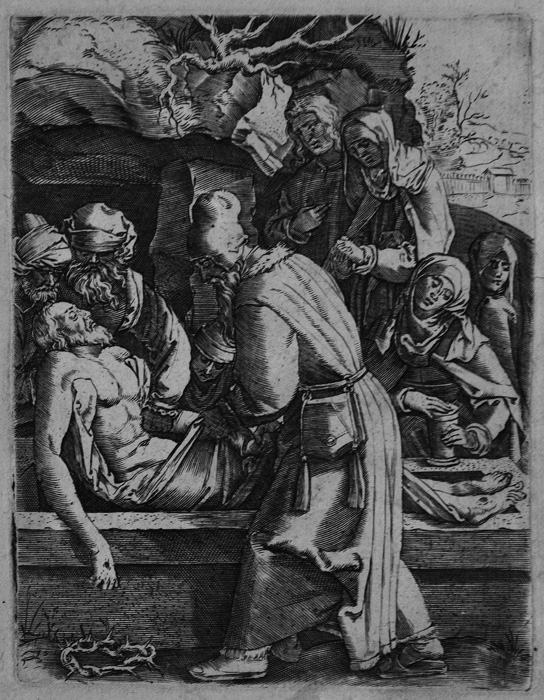 |
|
|
|
Pilate washes his hands after condemning Jesus. Reverse copy of Marcantonio's engraving after Dürer's woodcut in his Small Woodcut Passion, c. 1512. Good impression on laid paper with small margins. Image size: 126x96mm. Price: Please call or email for current pricing information.
|
|
|
|
|
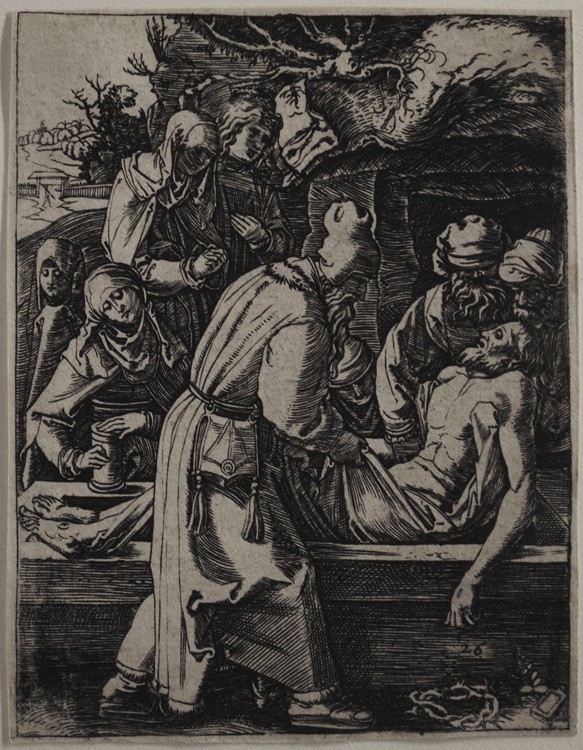 |
|
Marcantonio Raimondi (Bologna 1480-1527), The Entombment (Bartsch 612 ii/iii). Engraving after Dürer's Small Woodcut Passion, c. 1512. Very rich impression on laid paper trimmed just within the platemark; "26" lower right; cartouche empty. Image size: 127x99mm. Price: Please call or email for current pricing information.
|
|
|
|
|
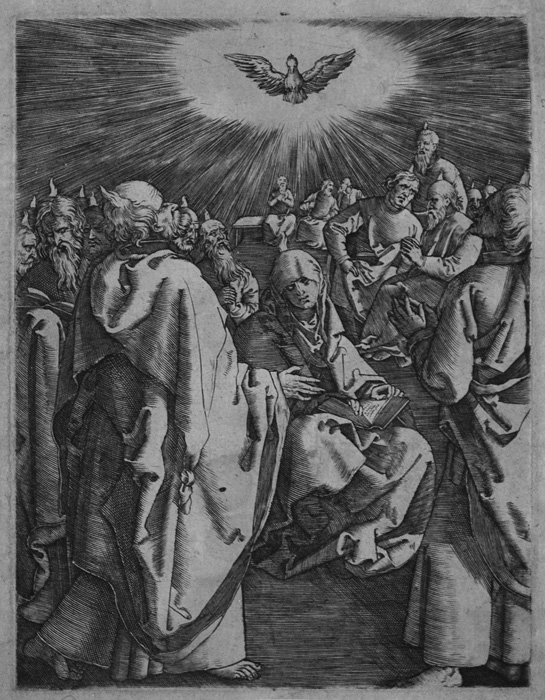 |
|
Pentecost. Reverse copy of Marcantonio's engraving after Dürer's woodcut in his Small Woodcut Passion, c. 1512. Good impression on laid paper with small margins. Image size: 126x98mm. Price: Please call or email for current pricing information.
|
|
|
|
 |
|
Marcantonio Raimondi (Bologna 1480-1527), Pentecost (Bartsch 619 iii/iii). Engraving after Dürer's Small Woodcut Passion, c. 1512. Very good impression on laid paper with thread margins; "34" in cartouche. The Holy Spirit in the form of a dove hovers over the Virgin and the Apostles illuminating the darkness and flames dance over the heads of all. Small interrupted red line beginning at the top of the aureole of light surrounding the dove and continuing just into its right wing. For a drawing based upon Dürer's version of this print, click here. Image size: 127x100mm. Price: Please call or email for current pricing information.
|
|
|
|
|
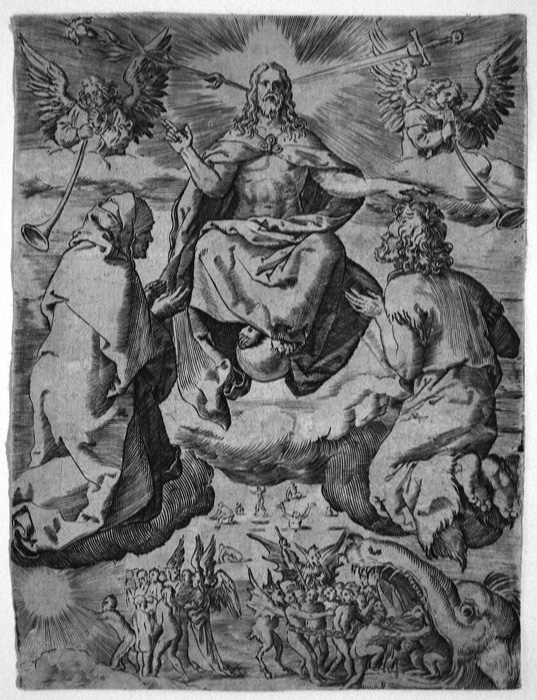 |
|
The Last Judgment. Engraving after Marcantonio's engraving after Dürer's Small Woodcut Passion, c. 1512. Good impression on laid paper with small margins. Image size: 125x100mm. Price: Please call or email for current pricing information.
|
|
|
|
|
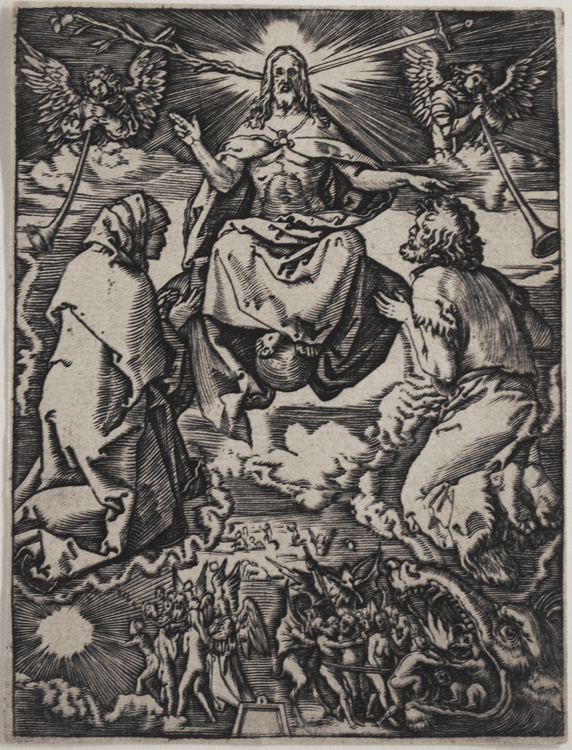 |
|
Marcantonio Raimondi (Bologna 1480-1527), The Last Judgment (Bartsch 620 i/iii). Engraving after Dürer's Small Woodcut Passion, c. 1512. Jesus comes on the clouds, heralded by angels blowing the last trumps and with the Virgin and John the Baptist kneeling in prayer on either side. Immediately below Jesus, the dead rise from their graves and are led to our left by angels toward the bright light of Heaven or forced to our right by devils who push them into the ultimate darkness of a giant hell-mouth in the form of a huge dragon-mouth. Coming from Jesus' mouth on our left is the lily of grace and on our right the sword of justice. A wonderful impression of this ultimate plate in the series in the first state of three. Image size: 127x100mm. Price: Please call or email for current pricing information.
|
|
|
|
|
|
|
As an exercise in connoisseurship, we hereby offer five different impressions of Jesus Carrying the Cross, three from Dürer's Small Woodcut Passion, one by Marcantonio, and one by the anonymous Italian engraver after Marcantonio. The first three were all made at different times from Dürer's woodblock, the Marcantonio is an engraving after Dürer, and the final impressions is from what I think is a mid-16th century copy of Marcantonio's engraving after Dürer. We hope that seeing the five together might help sharpen perceptions of difference (and similarity) as well as seeing how a block ages as it is printed and how an engraving's aesthetic impact may differ from that of a woodcut.
|
|
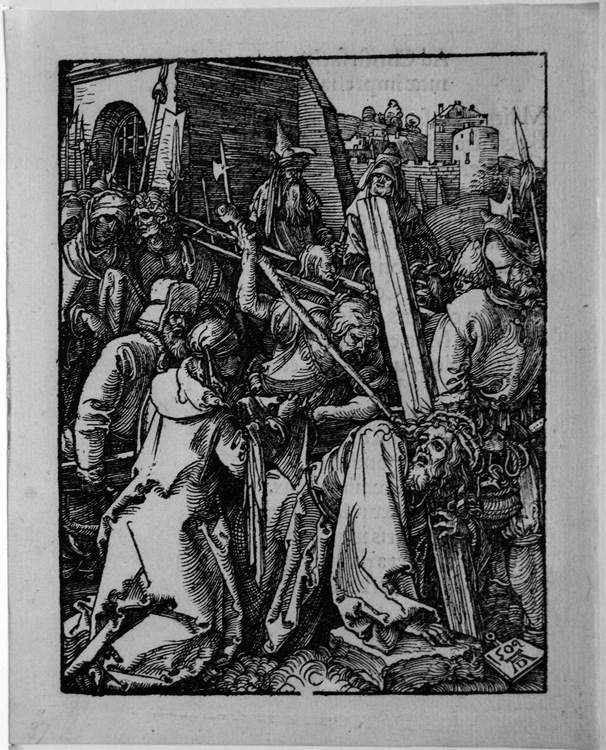 |
|
|
|
Christ Carrying the Cross (B. 37, S. 122). Original woodcut, 1509. A brilliant impression from the 1511 first edition with the Latin text on the verso printed on laid paper with an unreadable partial watermark and with wide margins. Strauss says, "Of all Durer's versions of this subject, this is the most remarkable. The emphasis is on the Savior's supporting arm, as if his body was suspended from it. A great effort on his part is required to turn his head, as he looks with an expression of helplessness at Veronica tendering her kerchief. It is no longer the pose of Orpheus, as in the Large Passion (no. 59), nor yet the erect figure, symbolizing the the spiritual relationship between the Son of God, and the believer, of the later engraved version" (p. 374). Signed & dated in the block. Meder's description of this woodcut precisely matches our print: "clear and flawless; a big gap lower center; a split upper right" (Strauss, p. 374). Comparing this impression with the other impression from the 1511 edition shown below, the split at the top right appears to be smaller on this impression, suggesting that it is a slightly earlier impression than the one below. One of the greatest prints of the Renaissance. Image size: 127x96mm. Price: Please call or email for current pricing information.
For the text on the verso, see below.
|
|
|
|
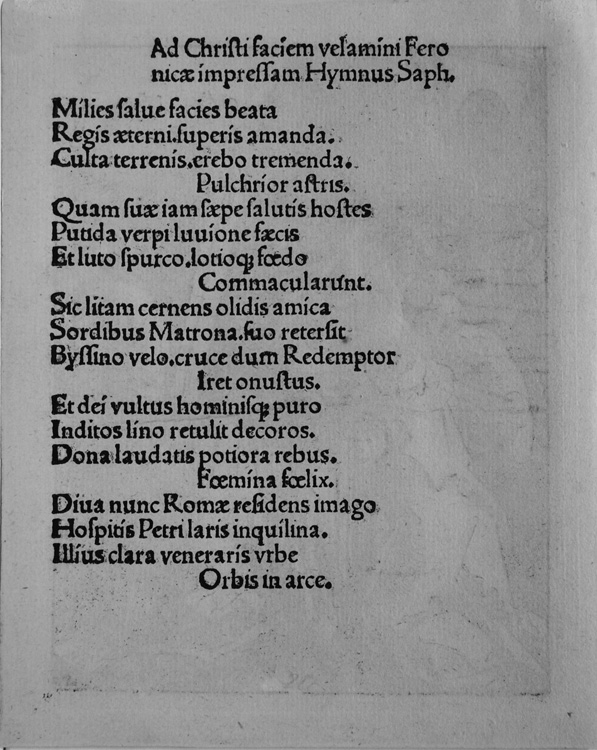 |
|
 |
|
Christ Carrying the Cross (B. 37, S. 122). Original woodcut, 1509. In 1844 plaster casts were made from Durer's original woodblocks for the Small Woodcut Passion, which had just been acquired by the British Museum. From these casts, metal plates were made and a small edition produced. Our impression is from this edition. Strauss says, "Of all Durer's versions of this subject, this is the most remarkable." Christ turns to St. Veronica, who is offering her kerchief, with a look of helplessness. On the upper left, St. John helps the Virgin Mary as she follows; an unidentified one of the holy women is behind the Virgin. Signed & dated in the block. One of the greatest prints of the Renaissance. For a very different interpretation, see Durer's woodcut for the Large Passion. See also the commentary upon it in Strauss. Image size: 127x96mm. Price: Please call or email for current pricing information.
|
|
|
|
|
|
In 1839, the British Museum purchased 35 of the original 37 woodblocks (which had last been published in Venice in 1612). Their condition was described in 1844 by Henry Cole, Assistant Keeper of The Public Records Office in London: "The blocks have suffered somewhat from age and wear. Some are worm-eaten, and the borders throughout are broken. . . . But in the present edition of them, the defects have been remedied by using stereotype casts of the blocks, which have been taken by a special permission of the trustees of the British Museum. New border lines have been added, the wormholes stopped, and those parts skillfully recut by Mr. Thurston Thompson. . . . The process of stereotyping has had the good effect of restoring almost the original sharpness and crispness of the lines, and of rendering the present impressions nearer the state of the earliest impressions than they would have been had they been taken from the original blocks themselves. This statement may seem paradoxical, but it will be seen that it has a reasonable explanation. In order to take a metal cast of a woodcut, a cast is first taken in moist plaster of Paris. This is thoroughly dried by baking, which causes it to shrink throughout, sometimes as much as an eighth of an inch in a cast of six inches in length. The result of this slight shrinkage has been to reduce these thickened lines nearly to their original fineness, and several of the present impressions are so crisp and clear that they will not suffer by a comparison with choice early impressions." Cole, who later became a Keeper at the Kensington St. Museum, now known as the Victoria and Albert Museum, supervised the printing and publication in 1844 of Dürer's Small Woodcut Passion, supplemented by modern copies of the two missing images, The Sitting Christ, which was used on the original titlepage, and Jesus Parting from his Mother, since the original woodblocks for both images had not survived. According to Walter Strauss's notes in the Dürer volumes in The Illustrated Bartsch, the original woodblocks are still in the British Museum and the metal casts are safely in the Victoria and Albert Museum.
|
|
 |
|
|
Marcantonio Raimondi (Bologna 1480-1527), Jesus carrying the cross (Bartsch 605 iii/iii). Engraving after Dürer's Small Woodcut Passion, c. 1512. A very good impression on laid paper trimmed on or within the platemark. "21" in cartouche. Image size: 131x100mm. Price: Please call or email for current pricing information.
|
|
|
|
|
 |
|
Jesus carrying the cross. Reverse copy of Marcantonio's engraving after Dürer's woodcut in his Small Woodcut Passion, c. 1512. Very good impression on laid paper with small margins. Image size: 126x98mm. Price: Please call or email for current pricing information.
|
|
|
|
|
Spaightwood Galleries, Inc.
To purchase, call us at 1-800-809-3343 (1-508-529-2511 in Upton MA & vicinity) or send an email to spaightwood@gmail.com. We accept AmericanExpress, DiscoverCard, MasterCard, and Visa.
We also accept wire transfers and paypal.
For directions and visiting information, please call. We are, of course, always available over the web and by telephone (see above for contact information). Click the following for links to past shows and artists. For a visual tour of the gallery, please click here. For information about Andy Weiner and Sonja Hansard-Weiner, please click here. For a list of special offers currently available, see Specials.
All works are sold with an unconditional guarantee of authenticity (as described in our website listing).
Go back to the top of this page.
Visiting hours: Saturday 10:00 am to 5:00 pm and Sunday noon to 6:00 pm and other times by arrangement.
Please call to confirm your visit. Browsers and guests are welcome.
|
|
|
|
|
|
|
|
|
|
|
|
|
|
|
|
|
|
|
|
|
|
|
|
|
|
|
|
|
|










